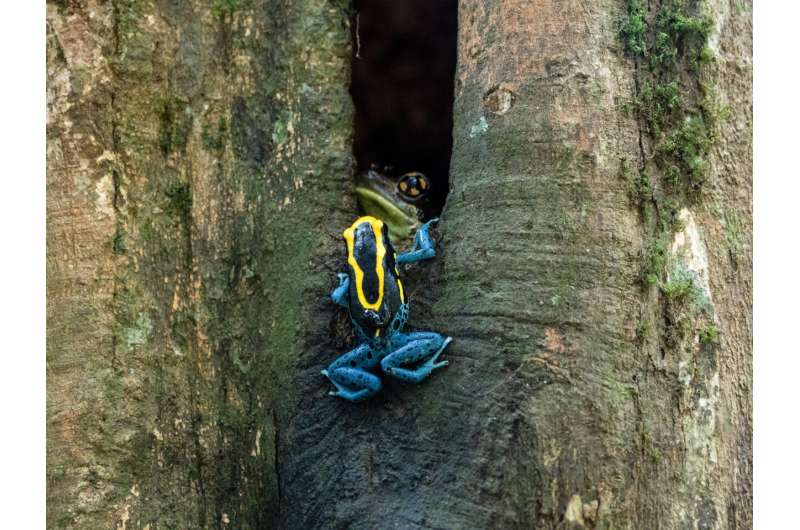Poison frog tadpoles can survive (almost) anywhere

A group of researchers from the University of Jyväskylä and Stanford University were part of an expedition to French Guiana to study tropical frogs in the Amazon. Amphibian species of this region use ephemeral pools of water as their nurseries and display unique preferences for specific physical and chemical characteristics. Despite species-specific preferences, researchers were surprised to find tadpoles of the dyeing poison frog surviving in an incredible range of both chemical (pH 3-8) and vertical (0-20 m in height) deposition sites. This research was published in the journal Ecology and Evolution in June 2021.
Unlike species in temperate regions, many neotropical frogs lay their eggs on the ground. This becomes an issue once tadpoles (who breathe using gills, like fish) hatch onto the forest floor, but poison frogs have developed innovative solutions to get their tadpoles to suitable aquatic habitats: piggy-back rides. In many of these terrestrial-breeding species, fathers will transport recently hatched tadpoles from the ground to pools of water formed by vegetation (like fallen trees or bromeliads).
Ph.D. researcher Chloe Fouilloux and team leaders Dr. Bibiana Rojas from University of Jyväskylä, Finland and Dr. Andrius Pašukonis from Stanford University wanted to know if different species (Dendrobates tinctorius, Allobates femoralis, and Osteocephalus oophagus) considered a combination of biological, physical, or chemical characteristics of pools when choosing nurseries for their young.
To find that out, this group of eight researchers sampled more than 100 pools over two years, which involved searching for suitable deposition sites that ranged from the ground to over 20 meter in vertical height (reached by climbing trees).
Of the three species, range and tolerance of D. tinctorius (dyeing poison frog) tadpoles was beyond what any of the researchers imagined physiologically possible: healthy tadpoles were found in a range of pools with a pH of around 3 to a pH of 8, which represents a 100,000x change of hydrogen ion concentration; in other words, these tadpoles were successfully developing in pools of what is chemically more acidic than orange juice to pools that have similar ionic concentrations to sea water.
The deposition choices of dyeing poison frogs confused researchers in other ways, too: tadpoles of this species are aggressive cannibals, which is why they are usually found to occur in low densities (1-2 tadpoles) per pool.
"However, in this study, we found several instances of more than 10 tadpoles of this species coexisting in the same nursery. The reason why fathers would deposit so many cannibals within the same pool, or if cannibalism occurs within these special pools, has yet to be tested," says Ph.D. researcher Chloe Fouilloux from University of Jyväskylä.
Healthier males transporting their tadpoles to more suitable conditions?
From a parental perspective, dyeing poison frog fathers were found to carry their tadpoles more than 20 meters above the forest floor: for a frog that is about 4 centimeters long; 20 meters is 500 times their body length. In human terms, this physical feat would be equivalent to having a 1.65 meter person climbing up a giant building of about 825 meters.
But why do fathers sometimes carry their tadpoles one meter away from where they hatched, and other times transport them to the tops of trees?
When looking at the chemical and biological trends, it appears that more biologically "comfortable" nurseries are found higher in trees. One possible explanation for this finding is that healthier males are able to invest more energy in transporting their tadpoles to more suitable conditions, but this is something that would need to be investigated in the future. Ultimately, there remains a lot to be learnt about the physiology and parental care of these animals; the degree of chemical flexibility found in these tadpoles is extremely unusual, and the secret underlying their resilience remains unknown.
"This work helps highlight the amazing diversity observed between and among species in the wild: Parents from different species prioritize unique characteristics when choosing pools to raise their offspring, which shapes both how species interact with each other and how they specialize in occupying different parts of the environment," says Dr. Bibiana Rojas from University of Jyväskylä.
This variation opens the door to future research that explores how species influence each other and how pool choice by parents affects tadpole development and survival.
More information: Chloe A. Fouilloux et al, Pool choice in a vertical landscape: Tadpole‐rearing site flexibility in phytotelm‐breeding frogs, Ecology and Evolution (2021). DOI: 10.1002/ece3.7741
Journal information: Ecology and Evolution
Provided by University of Jyväskylä




















